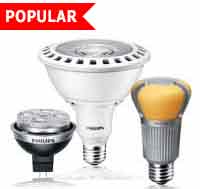Color Temperature: A Guide for the Perplexed
 If you have ever read anything about lighting or purchased a light bulb, you may have very well come in contact with color temperature. Color temperature is an important characteristic of light, and when it comes to choosing a light bulb, it is among the most important considerations. With this in mind, this article will dedicated to color temperature and will provide you with everything you need to know about it. Most basically, color temperature denotes the hue of the light of a given light source. As basic rules of the color temperature scale, warm light is understood up to 2,800K and cool light typically ranges from 3,600K to 4,9000K. In terms of actual hue, warm color will range from yellow to reddish and cool color will range from blue to white. There are other important markers on the color temperature scale that come up and should be noted. For photographers and filmmakers, knowing the color temperature of daylight (5,500K to 6,000K) is an important in attempting to conjure a daylight effect. In lighting especially, you may come across the designation ‘full-spectrum’ light. Full-spectrum light refers to light with a color temperature of 5,000K an up. More specifically, full-spectrum means that the light contains all of the wavelengths from infrared light to ultraviolet, meaning it is the full-spectrum of visible and non-visible light. Full-spectrum light is particularly sought after in greenhouses because it mimics sun light and is excellent for plant growth.
If you have ever read anything about lighting or purchased a light bulb, you may have very well come in contact with color temperature. Color temperature is an important characteristic of light, and when it comes to choosing a light bulb, it is among the most important considerations. With this in mind, this article will dedicated to color temperature and will provide you with everything you need to know about it. Most basically, color temperature denotes the hue of the light of a given light source. As basic rules of the color temperature scale, warm light is understood up to 2,800K and cool light typically ranges from 3,600K to 4,9000K. In terms of actual hue, warm color will range from yellow to reddish and cool color will range from blue to white. There are other important markers on the color temperature scale that come up and should be noted. For photographers and filmmakers, knowing the color temperature of daylight (5,500K to 6,000K) is an important in attempting to conjure a daylight effect. In lighting especially, you may come across the designation ‘full-spectrum’ light. Full-spectrum light refers to light with a color temperature of 5,000K an up. More specifically, full-spectrum means that the light contains all of the wavelengths from infrared light to ultraviolet, meaning it is the full-spectrum of visible and non-visible light. Full-spectrum light is particularly sought after in greenhouses because it mimics sun light and is excellent for plant growth.It is helpful to realize that color temperature was first established using incandescent bulbs as its standard of measurement. Therefore, there can be some difficulty in matching fluorescent and other types of light bulbs to standard color temperatures. The color temperatures of light bulbs that are not incandescent sometimes follow correlated color temperature (CCT) rather than color temperature. Don’t be confused, the only difference between the two scales is that CCT is an approximation of regular color temperature: so if you were to compare an incandescent bulb of a certain color temperature and a fluorescent bulb of the same color temperature they may not be identical. CCT is not very widely used, this is especially the case as bulbs like CFLs are more refined and more closely resemble the light of incandescent bulbs. People are sometimes confused about the difference between color temperature and the color rendering index (CRI) as well. CRI denotes the ability of a light source to represent colors as they appear in natural light. The higher the CRI (max 100), the closer the light source is rendering color naturally. What can be somewhat counter intuitive is that a light source can have a color temperature in the daylight range but have an imperfect CRI score, meaning that it doesn’t portray color naturally.
Color temperature is important in creating ambiance whether it is in your, restaurant, retail space, or even on your stage. BulbAmerica stocks light bulbs with a vast range of color temperatures; from the orange lights of low pressure sodium bulbs to the bright whites of LEDs we have them all. Check us out today!












Comments